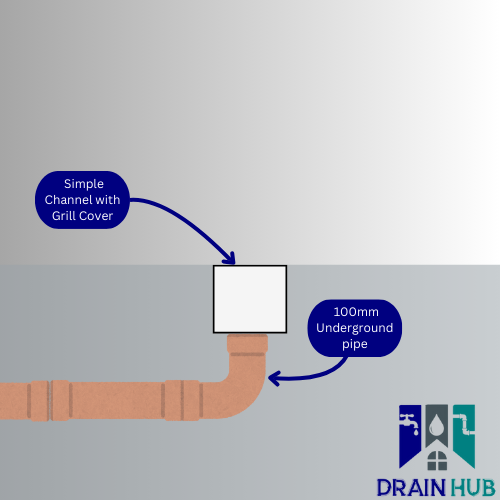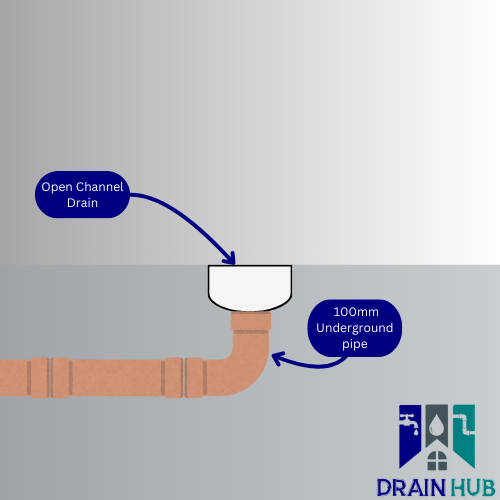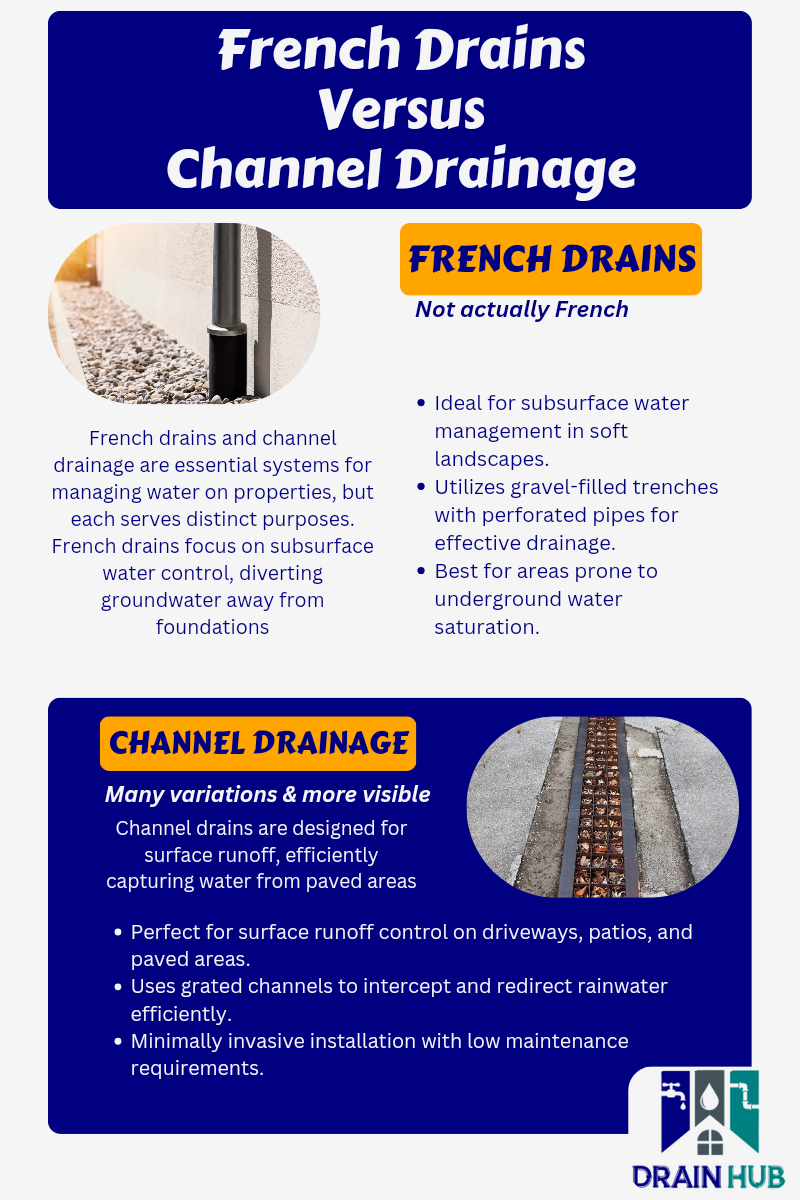What’s the difference?
Fundamentally, both are effective ways of moving surface water (rain water from above, sub surface water from below or a combination of both).
Managing water flow on your property is crucial to protect against damage, safeguard structures, and maintain a safe environment. Whether you’re dealing with surface runoff or groundwater buildup, selecting the right drainage solution—be it French drains or channel drains—can make all the difference. Here, we break down both systems to help you decide which one best fits your landscape and budget.
French Drains vs. Channel Drainage Systems: Differences and Where to use Them
Depending on the drainage issue you’re dealing with, you may need to install one of these options.
In regions prone to heavy rainfall or flooding, both French drains and channel drains can be effective but each caters to different needs.

French Drains
Designed as subsurface drainage systems, these involve gravel-filled trenches combined with perforated pipes. The objective is to redirect groundwater away from areas prone to water accumulation, such as basements or lawns. This is important for protecting foundations and basements.
Channel Drainage
Surface drainage solutions that intercept water runoff using grated channels. These are optimal for paved surfaces like driveways, patios, and commercial spaces like car parks where getting large volumes of surface water water away quickly is important.
Usually the ground in these areas are compacted and solid, rather than permeable.

Understanding when to install which type of rainwater drain allows property owners to make informed decisions, ensuring the most effective water management for the type of property you’re maintaining.
What are French Drains and how do They Work?
French Drains focus on getting rid of water already in the ground. More common in older properties and historic buildings, they are a versatile design allowing areas prone to water-logging to drain effectively.
French Drain Consist of:
Gravel-filled Trenches – to allow water to flow through the gaps from where you don’t want it to where it can get away.
Permeable Landscape Fabric – to prevent soil and other solids from clogging the drainage system. Also, I think, allows the water to flow at a controlled rate.
Perforated Pipes – Allows a large volume of water to be collected and moved away from sensitive areas.
These parts all work harmoniously to protect foundations, reduce soil saturation, and prevent moisture damage.
Types of French Drains
Basic French Drain

A simple gravel trench without pipes, suitable for low-volume drainage needs.
Pipe-filled French Drain

Incorporates perforated pipes within the trench, increasing water flow capacity—ideal for larger, waterlogged areas.
Interior French Drain

Typically installed in basements to prevent water ingress, with collected water funnelled to a sump pump system.
Installing French Drains
Installing this kind of drain can be labour intensive compared to other drains, as they require significant trenching and often need to be installed near foundations – so safer to dig by hand rather than an excavator. This is especially important near historical structures or established hardscaping.
Key Advantages
- Excellent for subsurface water management, particularly in expansive gardens or areas prone to waterlogging.
- Protects building foundations by diverting water away from critical zones.
Notable Drawbacks
- High installation costs due to the extensive excavation required.
- Prone to clogging over time, necessitating regular maintenance to clear sediment buildup.
What are Channel Drains and how do they Work?
Commonly referred to as “Aco,” channel drains are simpler and generally more visible compared to French Drains.
Channel drains are specifically engineered for surface water control, taking away a large volume of run-off in a built up area, such as car parks – where there is usually no capacity for water to be absorbed into the ground.
Channel Drains Consist of:
Channels – that run along the ground surface to collect water runoff.
Grates – covering these channels to prevent debris from entering while allowing water to pass through seamlessly.
Most channel drainage products have a built in bottom outlet which can be cut or broken open, allowing the channel to connect to an outlet usually in the form of a 100mm underground pipe which will then take the water to the rest of the surface water drainage system.
Types of Channel Drains
Aco Channels

Ideal for residential and commercial applications due to their durability and ease of maintenance.
Open Channels

Common in parking lots and industrial settings, where high water capacity is necessary.
Concrete Slot Drains

Used in heavy-duty areas like loading docks or high-traffic roads, these drains offer exceptional durability but at a higher cost.
Installing Channel Drainage
Channel drains are easier to install than French drains, with only shallow trenching required along paved surfaces. This minimal disruption makes them much easier, however if you’re adding drains to an already
Key Advantages
- Cost-effective and relatively straightforward to install.
- Minimal maintenance due to protective grates that block debris.
Notable Drawbacks
- Limited to managing surface water runoff; less effective in dealing with deep subsurface drainage needs.
- Not ideal for soft, unpaved areas where water may permeate the soil.
Comparing Costs and Feasibility
Investing in a drainage system requires careful cost analysis. Below is a detailed comparison to help guide your decision:
| Criteria | French Drains | Channel Drains |
|---|---|---|
| Installation Complexity | High – requires deep excavation | Low – surface-level installation |
| Cost per Metre | £45 – £70 | £25 – £50 |
| Maintenance Needs | Moderate to high – regular checks required | Low – occasional grate cleaning |
Decision-Making Guide: Which System to Choose?
When to Opt for French Drains
When to Select Channel Drains
Maybe a Combination French Drains and Channel Drains are Needed?
| System | Best For | Ideal Locations |
|---|---|---|
| French Drains | Subsurface water control | Soft landscapes, gardens |
| Channel Drains | Surface runoff management | Driveways, paved areas |
| Combination | Mixed-use properties | Urban/rural settings |
Still not Sure?
Every drainage system has its pros and cons, and the right choice depends on your property’s needs.
French drains are great for handling water below the surface, especially in soft, grassy areas, while channel drains are ideal for dealing with rainwater on hard surfaces like driveways and patios. If your property has a mix of these issues, combining both systems could give you the best results.
Choosing the right solution comes down to your specific landscape, the sensitivity of your buildings, and your budget. For expert advice and the perfect drainage plan, reach out to DrainHub today—we’re here to help you protect your property from water issues with confidence.
If you need any impartial advice on your particular project or problem, feel free to email us!


Leave a Reply